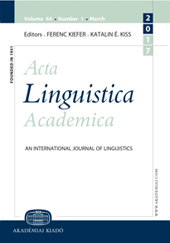HATNÉK-nominalization - Two subtypes of a highly verbal Hungarian deverbal nominalization
HATNÉK-nominalization - Two subtypes of a highly verbal Hungarian deverbal nominalization
Author(s): Gábor Alberti, Judit Farkas, Veronika SzabóSubject(s): Language studies, Syntax, Finno-Ugrian studies
Published by: Akadémiai Kiadó
Keywords: deverbal nominals; Hungarian; cartographic generative syntax; split-DP Hypothesis;
Summary/Abstract: The paper discusses two subtypes of a special kind of Hungarian deverbal nominalization, “HATNÉK-nominalization”, whose derivational suffix -hAtnék coincides with a sequence of the following three verbal suffixes: (i) the permissive modal suffix -hAt ‘can’, (ii) the conditional suffix -né-, and (iii) a number-person suffix -k. Within the system of Hungarian deverbal nominalizations, a very high degree of verbalness is typical of both HATNÉK-noun subtypes, of which we attribute a Giusti-style split-DP structure to the basic type, while the other, special, subtype is argued to have an exceptional structure with an “unboundedly expandable” (Spec,NP) position, capable of hosting huge verbal “inclusions”.
- Issue Year: 64/2017
- Issue No: 2
- Page Range: 169-190
- Page Count: 22
- Language: English

